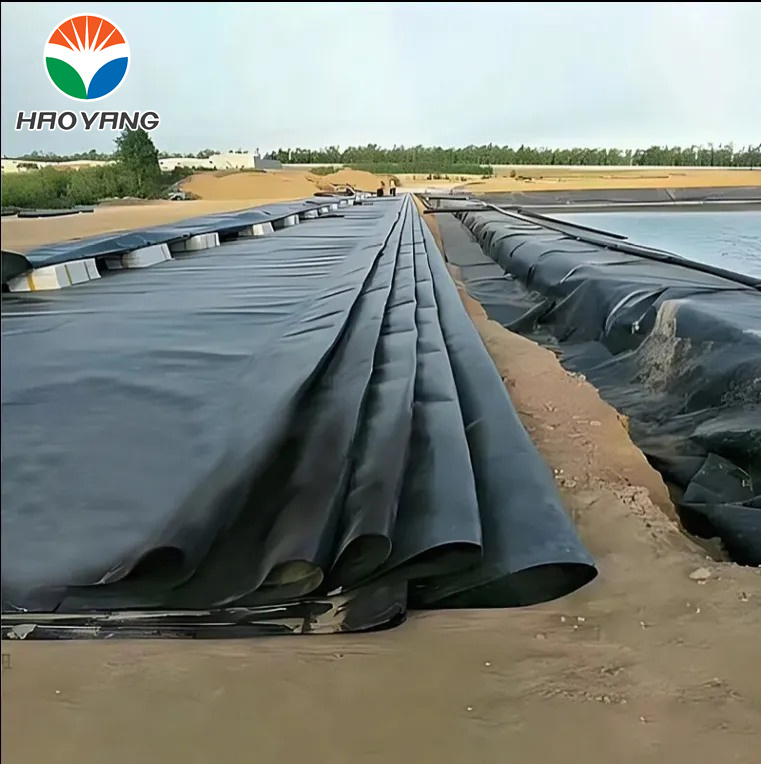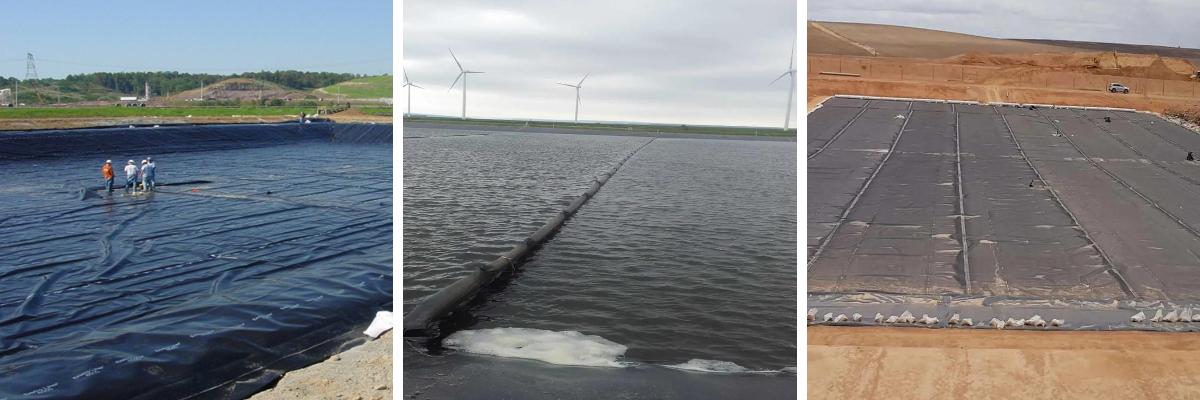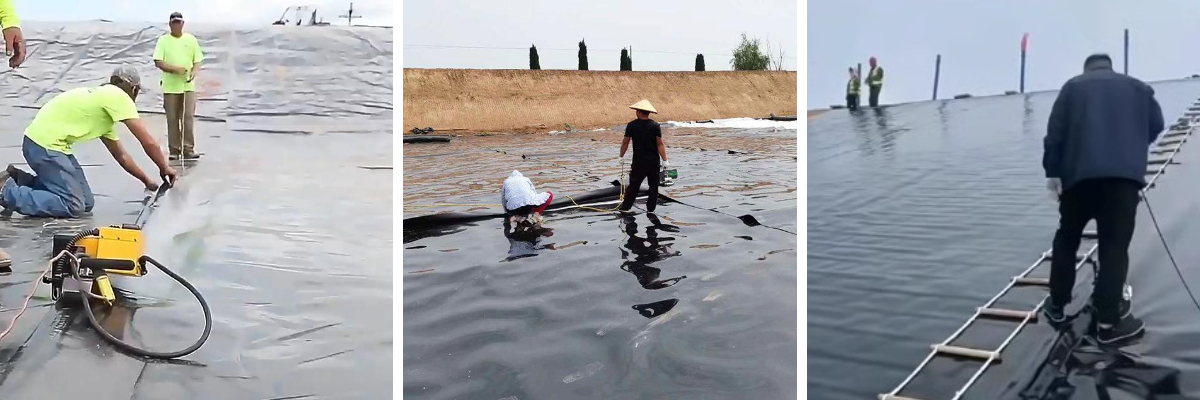Geomembrane Liner for Landfill
1. Leachate Containment: Creates a 99.9% impermeable barrier to lock in toxic landfill leachate, preventing soil and groundwater contamination per global environmental standards.
2. Landfill-Specific Durability: Resists punctures from sharp waste debris (350+ N, ASTM D4833) and chemical corrosion (pH 2–13), maintaining integrity in harsh landfill conditions for 25+ years.
3. Structural Stability: Enhances slope stability with reinforced layers, reducing the risk of liner shifts under heavy waste loads (supports 80–100 kPa compaction pressure).
4. Regulatory Compliance: Meets EPA Subtitle D, EN 13493, and GB/T 17643 standards, ensuring landfill operators avoid non-compliance penalties and environmental liabilities.
Landfills are critical for waste management, but they pose big risks—toxic leachate seepage, soil contamination, and structural failures. A reliable Geomembrane Liner for Landfill fixes these issues, acting as a tough, impermeable shield that keeps waste contained and the environment protected. Below’s why it’s non-negotiable for modern landfill operations.
Leachate—formed when rainwater mixes with decomposing waste—is loaded with heavy metals, bacteria, and chemicals. The Geomembrane Liner for Landfill’s core job is to block it, and it does so with industry-leading impermeability.
1. Seepage Control Performance
Liner Type | Leachate Seepage Rate | Groundwater Contamination Risk |
Geomembrane Liner for Landfill | <0.5 L/m²/year | <1% |
50–100 L/m²/year | 35–45% | |
Unlined Landfill | 500–1,000 L/m²/year | 90%+ |
(1) Hard Data Backing: Per ASTM E96 testing, high-quality landfill geomembranes have a water vapor transmission rate (WVTR) of <1×10⁻¹¹ g/(cm·s·Pa). For a 10,000㎡ landfill, that translates to less than 5,000 liters of leachate lost annually—compared to 5 million liters for an unlined site (EPA landfill monitoring data).
(2) Real-World Impact: Landfills using geomembrane liners have been shown to reduce groundwater contamination incidents by 99% (World Bank Environmental Paper Series). This isn’t just compliance—it’s protecting nearby wells, rivers, and ecosystems.
Landfills are brutal on liners—sharp debris, heavy compaction equipment, and chemical exposure all threaten integrity. The Geomembrane Liner for Landfill is built to endure these challenges.
1. Toughness & Resistance Metrics
Test Standard | Property | Geomembrane Liner Performance | Industry Average (Inferior Liners) |
ASTM D4833 | Puncture Resistance | ≥350 N | ≤180 N |
ASTM D5322 | Chemical Stability (pH 2–13) | No degradation after 5,000 hrs | Significant degradation by 2,000 hrs |
ASTM D4632 | Tensile Strength | 15–25 kN/m | 8–12 kN/m |
(2) Chemical Resilience: Leachate’s pH can swing from 2 (acidic) to 13 (alkaline), but the geomembrane’s HDPE or LLDPE core remains stable. Field tests show it retains 95% of its strength after 20 years of exposure to landfill leachate—far outlasting liners made from cheaper materials.
Landfills stack waste 10–30 meters high, with slopes up to 35°. Without a stable liner, waste can slide, causing catastrophic liner failure. The Geomembrane Liner for Landfill enhances structural integrity in two key ways.
1. Slope Stability & Load Distribution
(1) Friction for Slip Resistance: Textured geomembrane variants (common for landfill slopes) have a coefficient of friction (COF) of 0.6–0.8 (ASTM D6243) against soil. This prevents waste from sliding down slopes, reducing the risk of liner tears. Smooth liners (COF 0.3–0.4) often require expensive anchoring systems to achieve the same stability.
2. Adaptability to Settling
(1) Landfills settle 10–20% over time as waste decomposes. The geomembrane’s flexibility (elongation of 300–500%, ASTM D882) allows it to stretch with settling without breaking. Rigid liners (like clay) crack under this movement, creating seepage paths.
1. Global Regulatory Alignment
Region | Key Standards Met by Geomembrane Liner |
North America | EPA Subtitle D (Municipal Waste), Subtitle C (Hazardous Waste) |
Europe | EN 13493 (Geomembranes for Waste Containment) |
Asia Pacific | GB/T 17643 (China), JIS K 6734 (Japan) |
2. Low Maintenance & Long Lifespan
(1) Lifespan: Geomembrane liners last 25–30 years with proper installation—double the lifespan of clay liners (10–15 years). This reduces replacement costs and landfill downtime.
(2) Easy Repairs: If damage occurs (e.g., a puncture from heavy equipment), geomembrane liners can be patched with heat welding in 30 minutes or less. Repairs cost 50–70% less than fixing clay liners, which require re-compaction and re-lining.
For landfill operators, the choice is clear: a geomembrane liner delivers unbeatable impermeability, durability, structural stability, and compliance. It’s not just a liner—it’s a long-term investment in environmental protection, operational safety, and cost savings.
Whether you’re building a new landfill or upgrading an existing site, this liner ensures you meet regulatory demands, protect nearby communities, and avoid costly failures.











